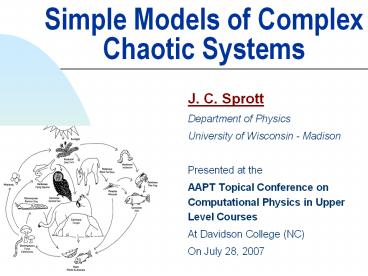Simple Models of Complex Chaotic Systems - PowerPoint PPT Presentation
Title:
Simple Models of Complex Chaotic Systems
Description:
The miracle of the appropriateness of the language of mathematics for the ... We should be grateful for it and hope that it will remain valid in future ... – PowerPoint PPT presentation
Number of Views:128
Avg rating:3.0/5.0
Title: Simple Models of Complex Chaotic Systems
1
Simple Models of Complex Chaotic Systems
- J. C. Sprott
- Department of Physics
- University of Wisconsin - Madison
- Presented at the
- AAPT Topical Conference on Computational Physics
in Upper Level Courses - At Davidson College (NC)
- On July 28, 2007
2
Collaborators
- David Albers, Univ California - Davis
- Konstantinos Chlouverakis, Univ Athens (Greece)
3
Background
- Grew out of an multi-disciplinary chaos course
that I taught 3 times - Demands computation
- Strongly motivates students
- Used now for physics undergraduate research
projects (20 over the past 10 years)
4
Mathematics
- The miracle of the appropriateness of the
language of mathematics for the formulation of
the laws of physics is a wonderful gift which we
neither understand nor deserve. We should be
grateful for it and hope that it will remain
valid in future research and that it will extend,
for better or for worse, to our pleasure, even
though perhaps also to our bafflement, to wide
branches of learning. - -- Eugene Wigner, 1960
5
Minimal Chaotic Systems
- 1-D map (quadratic map)
- Dissipative map (Hénon)
- Autonomous ODE (jerk equation)
- Driven ODE (Ueda oscillator)
- Delay differential equation (DDE)
- Partial diff eqn (Kuramoto-Sivashinsky)
6
What is a complex system?
- Complex ? complicated
- Not real and imaginary parts
- Not very well defined
- Contains many interacting parts
- Interactions are nonlinear
- Contains feedback loops ( and -)
- Cause and effect intermingled
- Driven out of equilibrium
- Evolves in time (not static)
- Usually chaotic (perhaps weakly)
- Can self-organize and adapt
7
Example The Weather
8
Bush-Kerry 2004 Race
9
Purple Map
10
Cellular Automaton
X1 X2 X3
XN
11
Example Game of Life
- The Rules
- For cells that are 'populated'
- Each cell with one or no neighbors dies, as if by
loneliness. - Each cell with four or more neighbors dies, as if
by overpopulation. - Each cell with two or three neighbors survives.
- For cell that are 'empty' (unpopulated)
- Each empty cell with exactly three neighbors
becomes populated.
12
Types of Models
Space Time State Model
Discrete Discrete Discrete CA
Discrete Discrete Continuous Maps
Discrete Continuous Discrete
Continuous Discrete Discrete
Discrete Continuous Continuous ODEs
Continuous Discrete Continuous
Continuous Continuous Discrete
Continuous Continuous Continuous PDE
13
Digital Computers
- Computers are cellular automata
- Space ? RAM
- 512 MBytes 4 x 109 bits
- Time ? CPU speed
- 2.4 GHz 2.4 x 109 binary ops/second
- State ? Bus width
- 32 bits 4 x 109 distinct values
- The program provides the rules whereby the CPU
updates the RAM
256-bit core memory
14
Is Nature Discrete or Continuous?
- No one knows
- Some states are quantized
- Electric charge, people, etc.
- Quantum of space?
- Planck length 1.6 x 10-35 meters
- Quantum of time?
- Planck time 5.4 x 10-44 seconds
- Uncertainty principle
- ?p ?x 10-35 kg-m/second
- ?E ?t 10-35 Joule-seconds
15
Characterization of Models
- Intrinsic vs. extrinsic
- Autonomous vs. nonautonomous
- Variables vs. parameters
- Stationary vs. nonstationary
- Slow vs. fast time scales
- Sensitive dependence vs. bifurcations
- Stochastic vs. deterministic
16
Dimension
- Spatial dimension (1, 2, 3)
- Not a fundamental property
- May provide guidance in choosing rules
- Not relevant to all models (social networks, Web,
financial markets, etc.) - Dynamical dimension (N)
- Number of variables (sites, people, etc.)
- Or number of required initial conditions
- Reduces the problem to a single trajectory in
N-dimensional space - May be infinite for continuous space
1 2 3
N
17
A Physicists Neuron
N
inputs
tanh x
x
18
A General Model (artificial neural network)
N neurons
Universal approximator, N ? 8
19
Route to Chaos at Large N (101)
Quasi-periodic route to chaos
20
What is the Simplest Complex NNet?
- Complex chaotic (positive LE)
- Apparently 6 neurons
- cf discrete-time systems with N 2
- 6 x 5 30 connections
- Can set 1 of 30 to zero
- Cannot all be 1
- With 7 neurons, all 42 can be 1
- Apparently no symmetric cases
21
(No Transcript)
22
(No Transcript)
23
Real Electroencephlagrams
24
Strange Attractors
25
Sparse Circulant Network (N101)
26
(No Transcript)
27
Labyrinth Chaos
dx1/dt sin x2 dx2/dt sin x3 dx3/dt sin x1
x1
x3
x2
28
Hyperlabyrinth Chaos (N101)
29
(No Transcript)
30
Minimal High-D Chaotic L-V Model
dxi /dt xi(1 xi 2 xi xi1)
31
Lotka-Volterra Model (N101)
32
(No Transcript)
33
Delay Differential Equation
34
(No Transcript)
35
Partial Differential Equation
36
(No Transcript)
37
Summary of High-N Dynamics
- Chaos is common for highly-connected networks
- Sparse, circulant networks can also be chaotic
(but the parameters must be carefully tuned) - Quasiperiodic route to chaos is usual
- Symmetry-breaking, self-organization, pattern
formation, and spatio-temporal chaos occur - Maximum attractor dimension is of order N/2
- Attractor is sensitive to parameter
perturbations, but dynamics are not
38
Shameless Plug
Chaos and Time-Series Analysis J. C.
SprottOxford University Press (2003) ISBN
0-19-850839-5
An introductory text for advanced
undergraduate and beginning graduate students in
all fields of science and engineering
39
References
- http//sprott.physics.wisc.edu/
lectures/models.ppt (this talk) - http//sprott.physics.wisc.edu/chaostsa/ (my
chaos textbook) - sprott_at_physics.wisc.edu (contact me)































